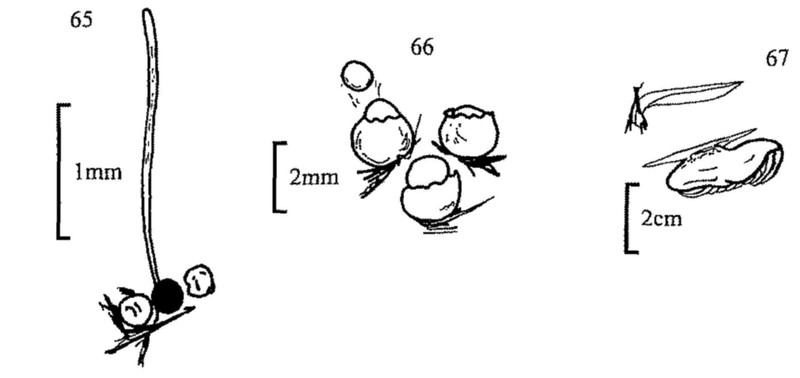|
1
|
Spores formed in multispored sporangia (figs 68, 70, 72, 75, 76) or in few-spored sporangioles (figs 70, 73).
|
2
|
|
-
|
Multispored sporangia and globose sporangioles absent. Spores formed singly on terminal, lateral or intermediate vesicles (figs 74, 79, 80, 82-86), or in short chains (figs 77, 78, 81).
|
11
|
|
2(1)
|
Sporangiophore stout, simple, with a subsporangial swelling and a basal swelling buried in the substrate. Sporangia tough walled, black, projected some distance towards the light when
mature, and sticking to whatever they hit.
|
|
Pilobolus (fig. 76)
|
|
e.g. spores pale yellow, 8-10 × 5-6µm -
|
P. crystallinus
|
|
spores orange, 12-20 × 6-10µm. -
|
P. kleinii
|
|
|
-
|
Sporangiophores not stout; sporangia not violently discharged.
|
3
|
|
3(2)
|
Sporangial wall black, tough, not readily broken when touched. Sporangia with a sticky base, becoming attached to whatever they contact after the marked elongation of the white
sporangiophores at maturity.
|
|
Pilaira (fig. 75)
|
|
e.g. spores yellowish, 8-10 × 6µm -
|
P. anomala
|
|
spores colourless, 11-13 × 6-8µm -
|
P. moreaui
|
|
|
-
|
Sporangial wall diffluent, spores readily removed in a droplet, or fragile and then spores easily dispersed by external violence.
|
4
|
|
4(3)
|
Sporangiophores stiff and metallic in appearance, growing towards the light and often to great length (5-30cm).
|
|
Phycomyces
|
|
e.g. spores 10.5-30 × 6.5-17µm; columella pyriform; sporangiophores up to 30cm -
|
P. nitens
|
|
spores 8-13 × 5-7.5µm; columella spherical or ovoid; sporangiophores up to 30cm -
|
P. blakesleeanus
|
|
|
-
|
Sporangiophores white, not reaching extreme lengths.
|
5
|
|
5(4)
|
Small lateral sporangia (sporangioles) present.
|
10
|
|
-
|
Sporangioles absent.
|
6
|
|
6(5)
|
Sporangiophores usually grouped, less often single, connected by stolon-like hyphae.
|
7
|
|
-
|
Sporangiophores arising singly, or if grouped then lacking stolon-like hyphae.
|
9
|

